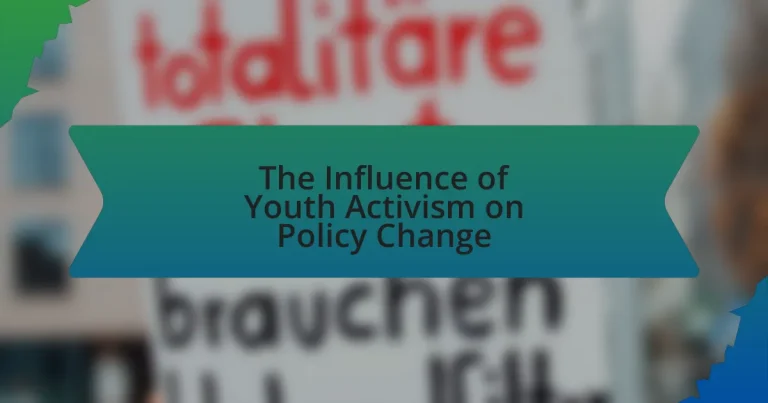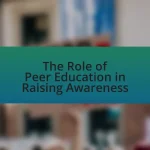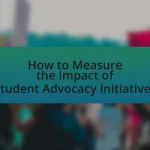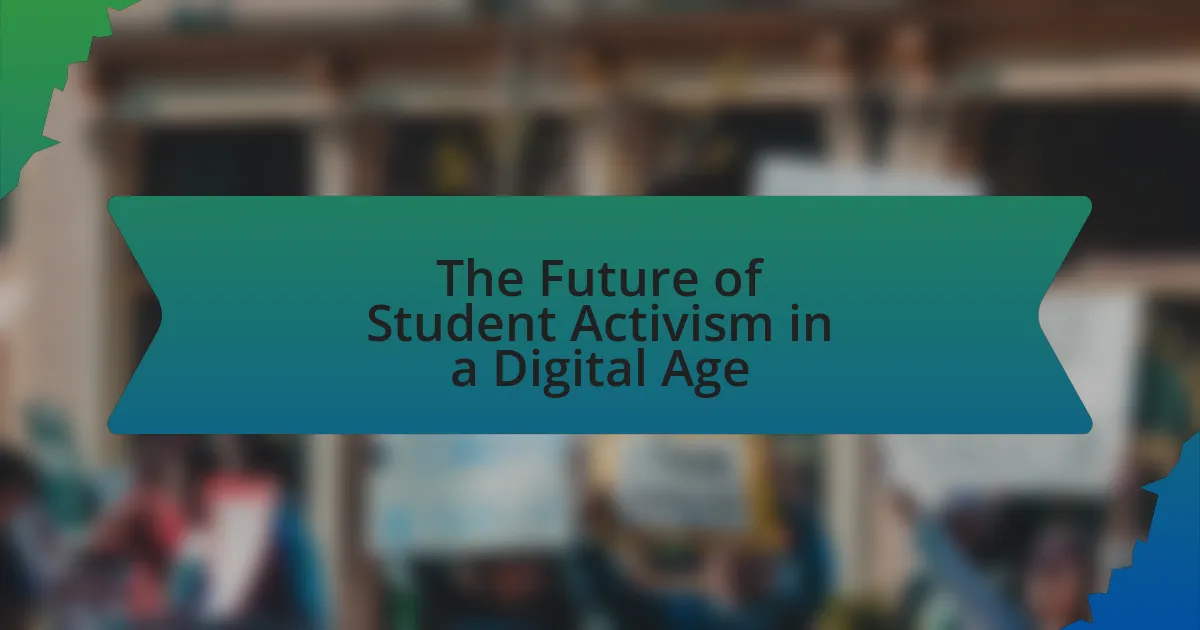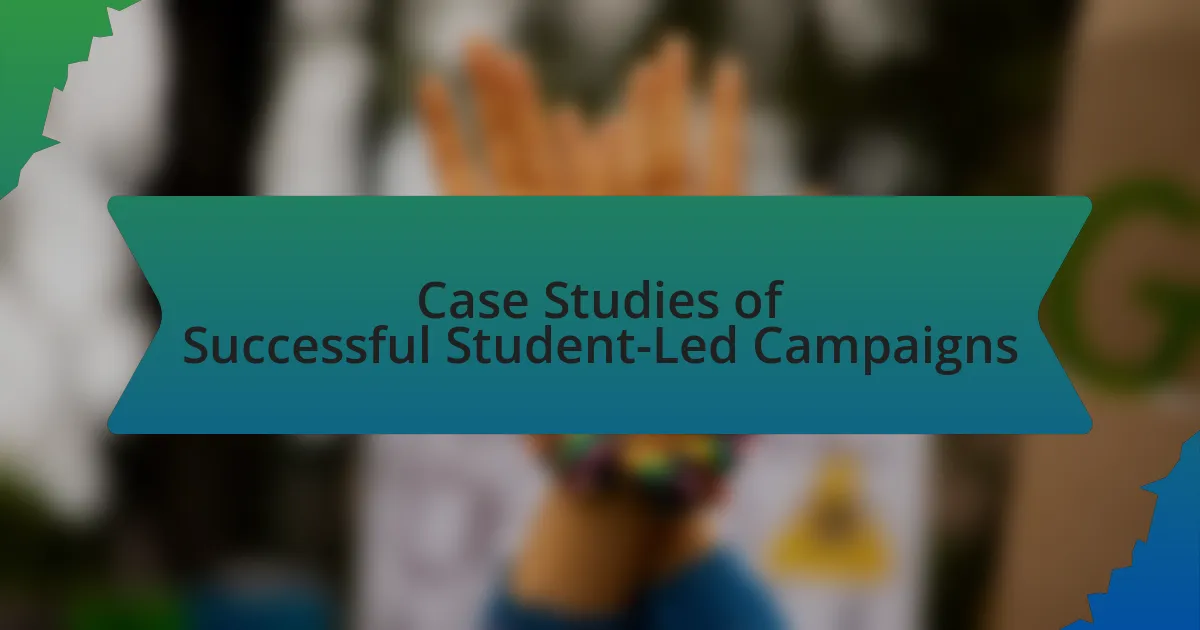Youth activism plays a crucial role in influencing policy change by mobilizing public opinion and pressuring decision-makers on critical issues such as gun control, climate change, and racial justice. Historical movements, including the Civil Rights Movement and anti-Vietnam War protests, demonstrate the effectiveness of youth-led initiatives in shaping legislation. Key events like the March for Our Lives and global climate strikes exemplify how organized youth efforts can lead to significant policy discussions and reforms. Despite facing challenges such as limited resources and generational biases, youth activists leverage social media and grassroots organizing to advocate for change, highlighting their unique perspectives and the importance of collaboration with established organizations. The article explores the impact of youth activism on policy, the strategies employed by young activists, and the outcomes of their efforts in driving legislative change.

What is the Influence of Youth Activism on Policy Change?
Youth activism significantly influences policy change by mobilizing public opinion and pressuring decision-makers. For instance, movements like the March for Our Lives, initiated by students after the Parkland shooting, successfully advocated for gun control measures, leading to legislative changes in several states. Additionally, youth-led climate strikes, inspired by Greta Thunberg, have prompted governments worldwide to commit to more aggressive climate policies, demonstrating the power of organized youth movements in shaping legislative agendas. These examples illustrate how youth activism can effectively drive policy reform through advocacy, awareness, and direct action.
How has youth activism historically impacted policy decisions?
Youth activism has historically impacted policy decisions by mobilizing public opinion and influencing legislative change. For instance, the Civil Rights Movement in the 1960s saw young activists, such as those involved in the Student Nonviolent Coordinating Committee, advocate for desegregation and voting rights, leading to the passage of the Civil Rights Act of 1964 and the Voting Rights Act of 1965. Similarly, the anti-Vietnam War protests, primarily driven by college students, contributed to shifting public sentiment and ultimately influenced U.S. withdrawal from Vietnam. These examples illustrate how youth activism has effectively shaped policy through organized efforts and strategic advocacy.
What key events exemplify youth activism’s influence on policy change?
Key events that exemplify youth activism’s influence on policy change include the March for Our Lives in 2018, which advocated for gun control following the Parkland shooting, leading to legislative discussions on gun reform in several states. Another significant event is the global climate strikes initiated by Greta Thunberg, which mobilized millions of young people and resulted in increased governmental commitments to climate action, such as the European Union’s Green Deal. Additionally, the Black Lives Matter movement, particularly the protests in 2020, prompted widespread policy reviews regarding police reform and racial justice across various jurisdictions. These events demonstrate how organized youth activism can effectively drive policy discussions and changes at local, national, and international levels.
How do historical movements shape current youth activism?
Historical movements significantly shape current youth activism by providing frameworks, strategies, and narratives that inform contemporary efforts. For instance, the civil rights movement of the 1960s established methods of nonviolent protest and grassroots organizing that today’s youth activists adopt in campaigns for racial justice and climate action. Additionally, the feminist movements have influenced current youth activism by promoting gender equality and empowering young women to advocate for their rights. The historical context of these movements serves as a reference point, illustrating the potential for collective action to effect change, as seen in the global youth climate strikes inspired by earlier environmental movements. This continuity demonstrates how lessons learned from past struggles inform the tactics and goals of today’s youth activists, fostering a sense of solidarity and urgency in addressing pressing social issues.
Why is youth activism important in today’s political landscape?
Youth activism is crucial in today’s political landscape because it drives significant social and political change. Young activists often bring fresh perspectives and innovative solutions to pressing issues such as climate change, racial justice, and education reform. For instance, the global climate strikes initiated by youth activists like Greta Thunberg have mobilized millions and influenced international climate policy discussions, demonstrating the power of youth voices in shaping public discourse and policy. Furthermore, studies show that youth engagement in activism correlates with increased voter turnout among younger demographics, highlighting their role in influencing electoral outcomes and policy decisions.
What unique perspectives do young activists bring to policy discussions?
Young activists bring fresh, innovative perspectives to policy discussions by prioritizing issues such as climate change, social justice, and equity, which resonate with their generation’s values. Their engagement often highlights the urgency of these issues, as evidenced by movements like Fridays for Future, which mobilized millions globally to demand action on climate change. Additionally, young activists leverage digital platforms to amplify their voices, creating a more inclusive dialogue that challenges traditional policy-making processes. This approach not only reflects their unique experiences but also emphasizes the need for policies that address the long-term impacts of decisions made today, ensuring that future generations are considered in the legislative process.
How does youth activism address contemporary social issues?
Youth activism addresses contemporary social issues by mobilizing young people to advocate for change, raise awareness, and influence policy decisions. This activism often focuses on pressing matters such as climate change, racial justice, and education reform, utilizing social media platforms to amplify their messages and organize events. For instance, the global climate strikes initiated by youth activists like Greta Thunberg have significantly impacted public discourse and prompted political leaders to prioritize environmental policies. Research indicates that youth-led movements have led to tangible policy changes, such as the adoption of more stringent climate regulations in various countries, demonstrating the effectiveness of youth activism in shaping contemporary social issues.
What challenges do youth activists face in effecting policy change?
Youth activists face significant challenges in effecting policy change, including lack of access to decision-making processes, limited resources, and generational biases. These obstacles hinder their ability to influence legislation and engage with policymakers effectively. For instance, many youth activists lack the financial support and organizational infrastructure that established advocacy groups possess, which can limit their outreach and impact. Additionally, policymakers may dismiss the perspectives of younger individuals due to preconceived notions about their experience and maturity, as evidenced by studies showing that youth voices are often underrepresented in political discussions. Furthermore, the rapid pace of social media can lead to fragmented movements, making it difficult for youth activists to unify their efforts and present a cohesive agenda to lawmakers.
How do systemic barriers hinder youth activism?
Systemic barriers hinder youth activism by creating obstacles that limit young people’s access to resources, platforms, and decision-making processes. These barriers include socioeconomic disparities, lack of representation in political spaces, and restrictive policies that discourage youth participation. For instance, a study by the National Youth Rights Association highlights that youth often face legal restrictions on organizing protests or engaging in political discourse, which diminishes their ability to advocate for change. Additionally, systemic inequalities in education and economic opportunities can prevent youth from gaining the skills and networks necessary for effective activism, ultimately stifling their voices in policy discussions.
What role does social media play in overcoming these challenges?
Social media serves as a crucial tool for youth activism in overcoming challenges related to policy change. It enables young activists to amplify their voices, mobilize support, and disseminate information rapidly. For instance, platforms like Twitter and Instagram have been instrumental in organizing protests and raising awareness about issues such as climate change and social justice, as evidenced by movements like #FridaysForFuture and Black Lives Matter. These platforms facilitate real-time communication and engagement, allowing activists to connect with a global audience, share resources, and coordinate actions effectively. Additionally, social media’s ability to bypass traditional media gatekeepers empowers youth to present their narratives directly, fostering greater visibility and influence in the policy-making process.

How do youth activists mobilize for policy change?
Youth activists mobilize for policy change through organized campaigns, grassroots movements, and digital platforms. They leverage social media to raise awareness, engage supporters, and disseminate information rapidly, exemplified by movements like #FridaysForFuture, which has mobilized millions globally for climate action. Additionally, youth activists often collaborate with established organizations to amplify their voices and influence policymakers directly, as seen in initiatives where young leaders participate in legislative hearings or advocacy days. This strategic combination of online and offline efforts has proven effective in driving significant policy discussions and changes, such as the adoption of more progressive climate policies in various countries.
What strategies do youth activists use to engage their communities?
Youth activists engage their communities through strategies such as social media campaigns, grassroots organizing, and community education initiatives. Social media campaigns allow activists to reach a wider audience quickly, mobilizing support and raising awareness about specific issues, as evidenced by movements like #FridaysForFuture, which effectively utilized platforms like Twitter and Instagram to engage millions globally. Grassroots organizing involves building local networks and fostering relationships within communities, enabling activists to address specific local concerns and create a sense of collective action. Community education initiatives, such as workshops and informational sessions, empower individuals with knowledge about social issues, encouraging active participation in advocacy efforts. These strategies collectively enhance community involvement and drive policy change by fostering informed and engaged citizenry.
How do grassroots movements contribute to policy advocacy?
Grassroots movements contribute to policy advocacy by mobilizing community members to influence decision-makers and raise awareness about specific issues. These movements often utilize strategies such as organizing protests, engaging in lobbying efforts, and leveraging social media to amplify their messages. For instance, the Black Lives Matter movement has effectively brought issues of racial injustice to the forefront of national policy discussions, resulting in legislative proposals aimed at police reform. Research indicates that grassroots efforts can lead to significant policy changes, as seen in the 2018 youth-led March for Our Lives campaign, which successfully advocated for gun control measures in various states.
What role do educational institutions play in mobilizing youth activism?
Educational institutions play a crucial role in mobilizing youth activism by providing a platform for education, engagement, and organization. They foster critical thinking and awareness of social issues through curricula that emphasize civic responsibility and social justice. For instance, universities often host workshops, lectures, and events that encourage students to participate in activism, as seen in the rise of movements like the March for Our Lives, which was significantly supported by student organizations on campuses. Furthermore, educational institutions can facilitate connections between students and community leaders, enhancing the impact of youth-led initiatives. Research indicates that students involved in campus activism are more likely to engage in civic activities post-graduation, demonstrating the long-term influence of educational environments on youth activism.
How do coalitions and partnerships enhance youth activism?
Coalitions and partnerships enhance youth activism by providing a unified platform that amplifies voices and resources. When youth organizations collaborate, they can pool their knowledge, skills, and networks, leading to more effective advocacy efforts. For instance, the collaboration between various youth-led groups during the March for Our Lives movement in 2018 demonstrated how partnerships can mobilize large numbers of participants and attract significant media attention, thereby influencing public policy discussions on gun control. This collective action not only increases visibility but also strengthens the legitimacy of youth demands, making it more likely for policymakers to respond to their calls for change.
What are the benefits of collaboration between youth organizations?
Collaboration between youth organizations enhances resource sharing, amplifies advocacy efforts, and fosters a stronger collective voice. By pooling resources, organizations can access a wider range of tools, funding, and expertise, which increases their overall effectiveness. For instance, joint initiatives can lead to larger outreach campaigns, as seen in the collaboration between various youth-led groups during climate strikes, which mobilized millions globally. Additionally, unified advocacy efforts can influence policy change more effectively, as demonstrated by the coordinated actions of youth organizations in the Black Lives Matter movement, which resulted in significant legislative discussions on racial justice. This synergy not only strengthens individual organizations but also creates a more impactful movement for social change.
How can youth activists effectively partner with established organizations?
Youth activists can effectively partner with established organizations by aligning their goals and values, which fosters mutual understanding and collaboration. Establishing clear communication channels is essential, allowing both parties to share resources, knowledge, and strategies. For instance, youth activists can leverage social media platforms to amplify the reach of established organizations, while these organizations can provide mentorship and access to networks that enhance the activists’ initiatives. Research indicates that partnerships between youth-led movements and established organizations can lead to more significant policy changes, as seen in the collaboration between youth climate activists and environmental NGOs, which has resulted in increased legislative attention to climate issues.
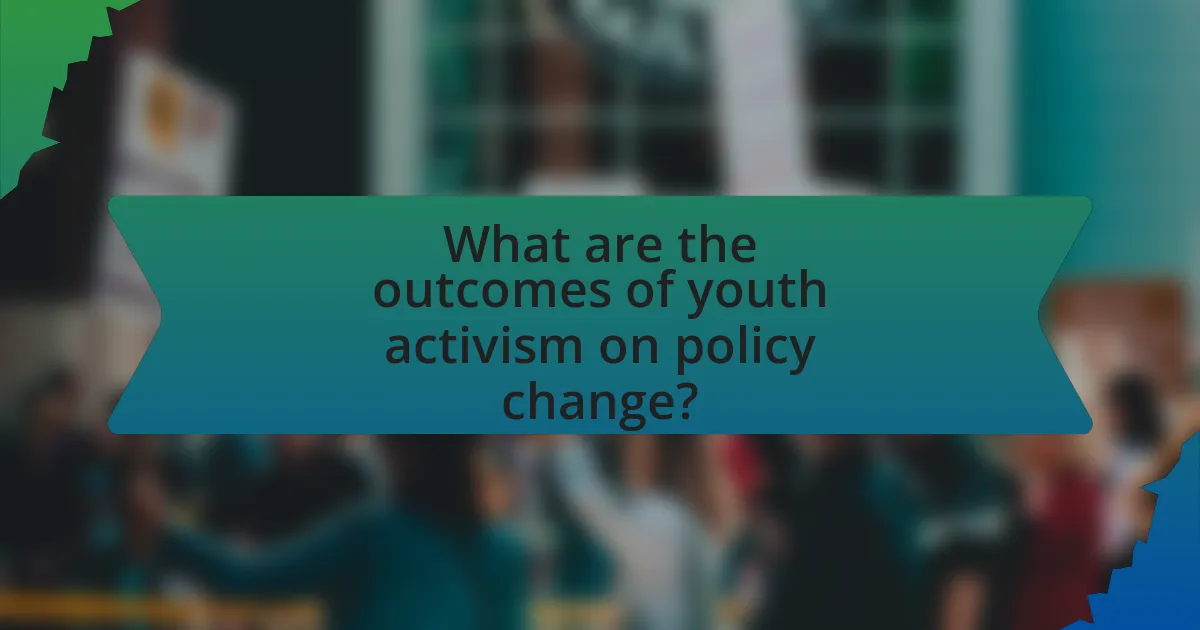
What are the outcomes of youth activism on policy change?
Youth activism leads to significant outcomes in policy change, including the implementation of new laws, shifts in public opinion, and increased political engagement among young people. For instance, the March for Our Lives movement, initiated by students after the Parkland shooting in 2018, successfully advocated for gun control measures, resulting in legislative changes in several states. Additionally, youth-led climate strikes have influenced global discussions on climate policy, prompting governments to commit to more ambitious climate goals, as seen in the increased urgency reflected in the Paris Agreement negotiations. These examples illustrate how youth activism not only drives immediate policy changes but also fosters a culture of civic participation and accountability.
How can we measure the success of youth-led initiatives?
Success of youth-led initiatives can be measured through specific metrics such as community engagement, policy impact, and sustainability of outcomes. Community engagement can be assessed by tracking participation rates in events and initiatives, which indicates the level of interest and involvement from the youth and the broader community. Policy impact can be evaluated by analyzing changes in legislation or policy that result from the initiatives, such as the adoption of youth-driven proposals or amendments. Sustainability of outcomes can be measured by the longevity of the initiatives and their ability to maintain momentum over time, including continued funding and support. These metrics provide a concrete framework for assessing the effectiveness and influence of youth-led initiatives on policy change.
What indicators reflect successful policy changes driven by youth activism?
Successful policy changes driven by youth activism are reflected by indicators such as the implementation of new laws, changes in government regulations, and shifts in public opinion. For instance, the passage of the Climate Action Now Act in the U.S. Congress in 2019 was influenced by youth-led movements advocating for climate change action, demonstrating how organized activism can lead to legislative outcomes. Additionally, measurable increases in youth voter turnout and engagement in political discourse often correlate with successful advocacy efforts, as seen in the 2020 U.S. elections where youth participation surged, impacting election results and policy discussions. These indicators collectively illustrate the tangible effects of youth activism on policy change.
How do youth activists assess the impact of their campaigns?
Youth activists assess the impact of their campaigns through various methods, including surveys, social media analytics, and policy changes. Surveys allow activists to gather feedback from participants and the community, measuring awareness and engagement levels. Social media analytics provide quantitative data on reach and interactions, indicating how effectively the campaign resonated with the audience. Additionally, tracking specific policy changes or commitments made by decision-makers in response to their campaigns serves as a concrete measure of success, demonstrating the tangible influence of their efforts on legislative processes.
What lessons can be learned from successful youth activism campaigns?
Successful youth activism campaigns demonstrate the importance of strategic organization and clear messaging. These campaigns often utilize social media effectively to mobilize support and raise awareness, as seen in movements like March for Our Lives, which galvanized youth around gun control and resulted in legislative discussions in various states. Additionally, successful campaigns highlight the power of collaboration, as youth groups often partner with established organizations to amplify their impact, exemplified by the collaboration between youth climate activists and environmental NGOs during the Global Climate Strikes, which drew millions of participants worldwide. Finally, persistence and adaptability are crucial, as campaigns that adjust their strategies in response to political climates or public sentiment, like the Black Lives Matter movement, have shown resilience and sustained influence over time.
What best practices emerge from effective youth-led policy changes?
Effective youth-led policy changes often emerge from best practices such as inclusive engagement, strategic communication, and evidence-based advocacy. Inclusive engagement ensures that diverse youth voices are represented, fostering a sense of ownership and commitment to the policy process. For instance, initiatives like the Youth Climate Strike have successfully mobilized thousands of young people globally, demonstrating the power of collective action in influencing climate policy.
Strategic communication involves crafting clear, compelling messages that resonate with both policymakers and the public. The March for Our Lives movement, which advocates for gun control, effectively utilized social media to amplify its message and mobilize support, showcasing how targeted communication can drive policy change.
Evidence-based advocacy relies on data and research to support policy proposals, enhancing credibility and persuasiveness. The work of organizations like the Global Youth Climate Network illustrates how presenting scientific evidence can effectively influence policymakers to adopt sustainable practices.
These best practices collectively contribute to the effectiveness of youth-led policy changes, as evidenced by successful movements that have led to tangible legislative outcomes.
How can future youth activists build on past successes?
Future youth activists can build on past successes by analyzing effective strategies and outcomes from previous movements. For instance, the climate strikes initiated by Greta Thunberg mobilized millions globally, demonstrating the power of grassroots organization and social media engagement. By studying these tactics, future activists can replicate successful outreach methods, adapt messaging to current issues, and leverage digital platforms for wider impact. Historical data shows that movements with clear goals and strong community involvement, such as the Civil Rights Movement, achieved significant policy changes, indicating that a focused approach can lead to tangible results.
What practical steps can youth activists take to influence policy effectively?
Youth activists can influence policy effectively by organizing grassroots campaigns that mobilize community support and raise awareness about specific issues. These campaigns can include petitions, social media outreach, and public demonstrations, which have historically proven to engage a wider audience and attract media attention. For instance, the March for Our Lives movement, initiated by students after the Parkland shooting, successfully advocated for gun control measures by leveraging social media to gather support and organize events, resulting in legislative discussions in various states. Additionally, youth activists should engage with policymakers directly through lobbying efforts, providing them with research-backed proposals and personal stories that highlight the impact of policies on their lives. This approach has been shown to create a compelling narrative that resonates with decision-makers, as evidenced by the success of climate activists who have influenced local and national climate policies by presenting scientific data alongside personal testimonies.
